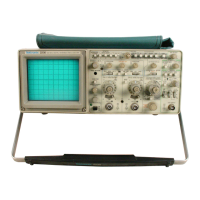--
POSITION TO
CENTERLINE
VERTICAL
DEFLECTION
MEASURE AMPLITUDE
FROM@TO@
Figure
6-17_
Peak-to-peak waveform voltage.
4998-30
8.
Measure the vertical deflection from peak to peak
(
see
Figure 6-17, Point A to Point
B).
NOTE
A more accurate
value
can be obtained
by
measur-
ing from the top
of
a peak to the top
of
a
valley.
This
eliminates trace thickness from the measure-
ment.
9.
Calculate the peak-to-peak voltage, using the follow-
ing formula:
Volts vertic~I VOL TS/DIV probe
= deflection x switch x attenuation
(p-p)
(divisions) setting factor
EXAMPLE:
The measured peak-to-peak vertical
deflection is 5 divisions
(see
Figure 6-17) with a
VOL TS/DIV switch setting of 0.5
V,
using a 10X probe.
Substituting the given values:
Volts
(p-p)
= 5 div X 0.5 V/div X
10
=
25
V
Basic
Applications-2230
Operators
GROUND REFERENCED DC VOLT AGE
NOTE
Either channel input connector may be used for the
signal input. Use the VERTICAL MODE switches
to
select the appropriate channel for display.
1.
Apply the signal to
be
measured to the selected
channel input
and
obtain a
NON
STORE display.
2.
Ensure that the VOL TS/DIV Variable control is
in
the calibrated detent
and
determine the polarity of the volt-
age to
be
measured
as
follows:
a.
Set the AC-GND-DC switch to
GND
and
vertically
position the baseline trace to the center horizon-
tal graticule line.
b.
Set the AC-GND-DC switch to
DC.
If the
waveform moves above the center line of the crt,
the voltage
is
positive. If the waveform moves
below the center line of the crt, the voltage
is
negative.
3.
Set the AC-GND-DC switch to
GND
and
position the
baseline trace to a convenient reference line. For example,
if the voltage to
be
measured
is
positive, position the
baseline trace to the bottom graticule line. If a negative
voltage
is
to
be
measured, position the baseline trace to
the top graticule line.
4.
Set the AC-GND-DC switch to
DC.
Measure the
divisions of vertical deflection between the reference line
and
the desired point
on
the waveform
(see
Figure 6-18).
5.
Calculate the voltage, using the following formula:
~ertical Polarity
Voltage = distance x ( ) x
(divisions) + or -
NOTE
VOLTS/DIV
switch
setting
The
attenuation factor
of
the probe being used must
be included
if it
is
not
a 1
OX
scale-factor-switching
probe.
6-17

